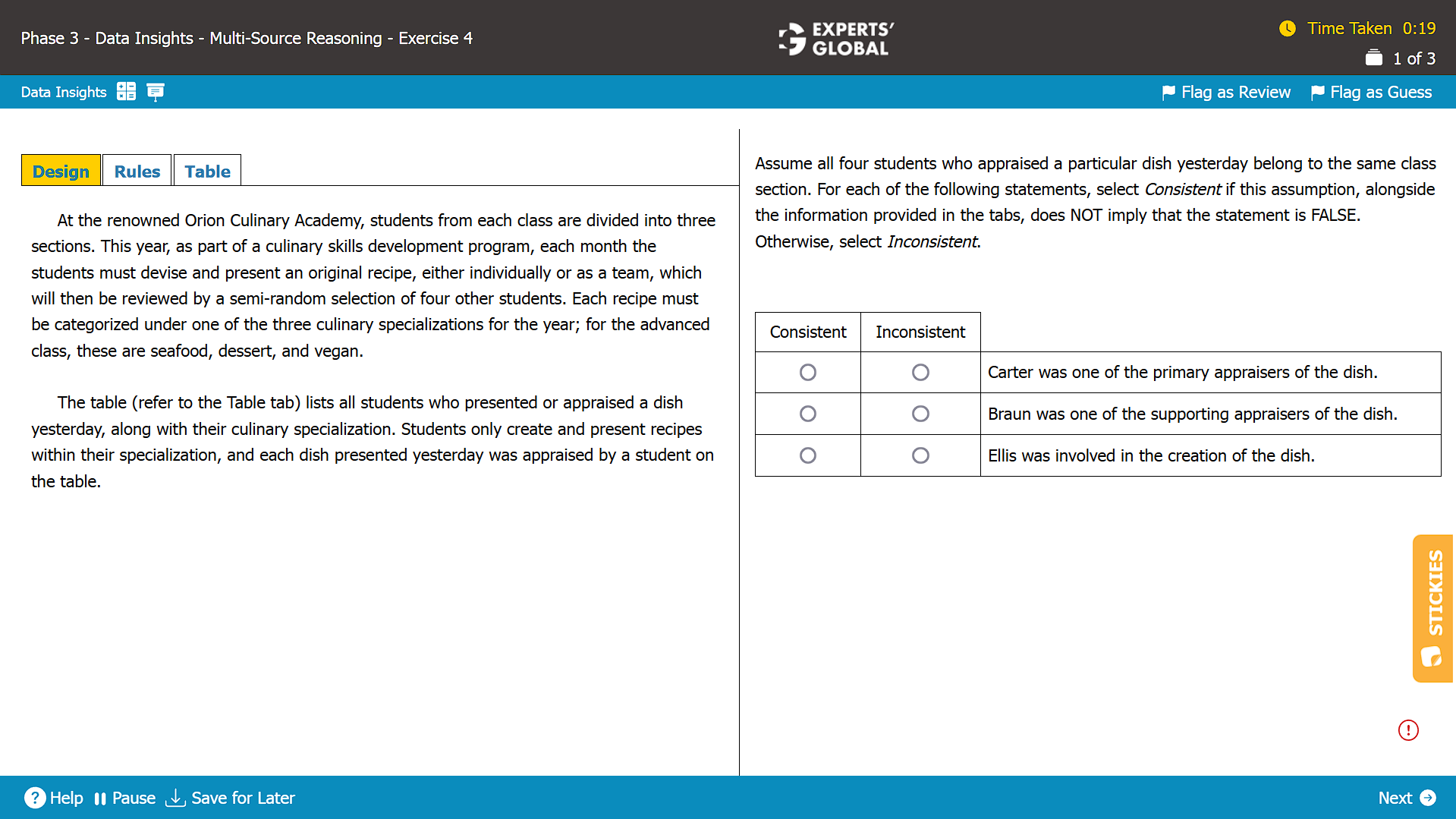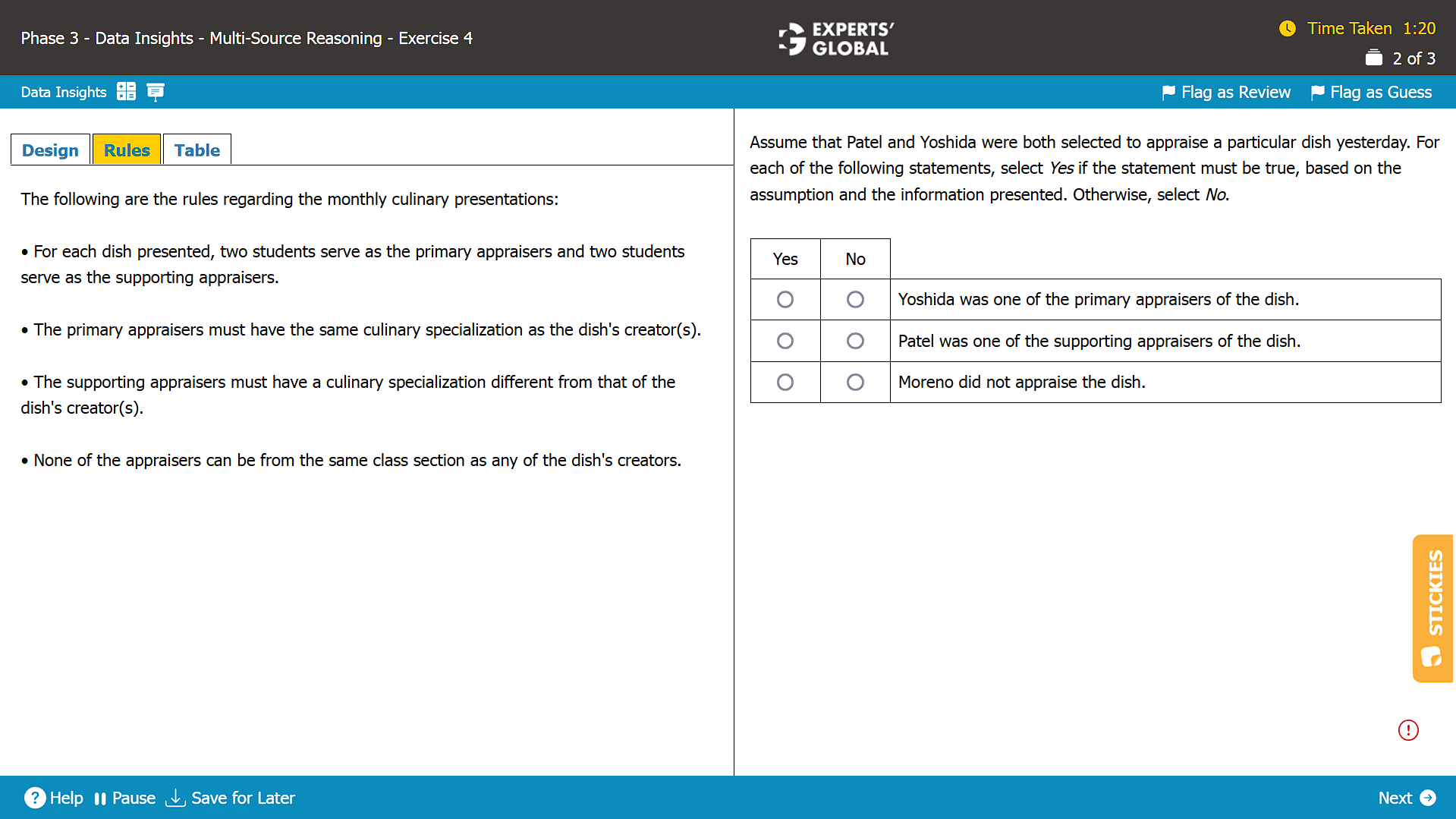Invest 30 seconds...
...for what may lead to a life altering association!
Help Line
- +91.8800.2828.00 (IND)
- 1030-1830 Hrs IST, Mon-Sat
- support@expertsglobal.com
...for what may lead to a life altering association!


Multi-Source Reasoning questions in the GMAT Data Insights section present information across multiple tabs, such as tables, charts, data summaries, and short passages. You must analyze and reconcile information across sources to answer three questions per set. The format tests reasoning, integration, and attention to detail.
To acclimatize with all GMAT question types, take a free full-length GMAT practice test
Multi-Source Reasoning (MSR) questions in the GMAT’s Data Insights section are designed to reflect how professionals evaluate fragmented information from multiple sources in real-world scenarios. Presented across separate tabs, these questions test your ability to filter, reconcile, and interpret diverse data quickly and logically. A structured GMAT prep course can help you build the analytical skills needed for MSR. This article explains the format, key skills tested, effective strategies, and common mistakes to avoid, making it a valuable resource whether you are just starting out or working to improve your performance.
Multi-Source Reasoning questions are presented in a tabbed format. Each tab contains a different piece of information, such as emails, memos, charts, excerpts from reports, or conversation transcripts. You can switch between the tabs at any time while answering the questions. Each MSR set typically includes three multiple-choice questions. These can be a combination of traditional multiple-choice and yes/no or true/false formats. The questions may test interpretation, evaluation, and integration of information across the tabs. The format mimics real-world situations in which a manager must make decisions based on scattered, sometimes contradictory data. For instance, a business leader may need to analyze internal memos, supplier correspondence, and financial reports before reaching a conclusion. The GMAT uses this question type to test how well candidates can replicate this real-world analytical process.



Correct Answer 1: Inconsistent-Consistent-Inconsistent
Correct Answer 2: No-Yes-Yes
Correct Answer 3: C
The MSR question type evaluates a range of critical thinking skills. These include:
You must combine and compare facts across multiple tabs. Often, one tab will qualify, clarify, or even contradict information in another.
You are expected to draw logical conclusions from complex data sets. Sometimes, this involves spotting contradictions or verifying consistency.
Some questions ask whether a particular statement is supported or weakened by the information provided. This tests your ability to judge relevance and reliability.
Though not testing reading comprehension in the traditional verbal sense, MSR requires quick and accurate reading of moderately complex business texts.
Small differences in wording, phrasing, or data presentation often affect the validity of conclusions. Careful reading is essential.
These are not simple retrieval tasks. You will rarely find the answer explicitly stated. You must interpret, deduce, and sometimes resolve conflicts between data points.
The three questions in a typical MSR set may follow different formats. These include:
For example, suppose Tab 1 is a company email discussing a new project, Tab 2 is a customer survey, and Tab 3 is a financial projection report. A question might ask, “Based on the information in the three tabs, is it reasonable to expect a positive ROI within six months?” You must then evaluate all three tabs to answer correctly.
Approaching MSR questions with a systematic strategy improves both accuracy and efficiency. Here are some tested methods:
Before answering any question, take a minute to skim through all the tabs. Understand the topic, tone, and purpose of each tab. This prevents you from misinterpreting the content by viewing it in isolation.
As you read each tab, mentally note the type of information it contains. For instance, Tab 1 could be a qualitative memo, Tab 2 a data chart, and Tab 3 a customer complaint summary. Knowing where each type of data is located helps you move quickly between tabs while answering questions.
Look for strong keywords that signal conclusions, recommendations, conditions, or changes. Also, pay attention to inconsistencies. Sometimes, two tabs will offer conflicting perspectives, and resolving these is the key to answering the question.
Although all three questions are based on the same tabs, treat each question independently. Do not let your answer to one question bias your reasoning for another.
For traditional multiple-choice questions, eliminate options that are clearly unsupported or contradicted by the information provided. This increases your odds even if you are unsure of the correct answer.
Your conclusions must be based strictly on the information presented in the tabs. Avoid drawing on outside knowledge or assuming more than what is stated or implied.
Success on Multi-Source Reasoning questions depends not only on what you do right but also on what you avoid doing wrong. Here are some common pitfalls:
The preparation for Multi-Source Reasoning questions in the GMAT Data Insights section can be organized into three structured stages, what we at Experts’ Global refer to as: Understand, Practice, and Master. Each stage targets a specific layer of readiness, allowing you to approach these complex, tab-driven questions with clarity, control, and strategic reasoning under time pressure.
Begin by developing a strong familiarity with the format of Multi-Source Reasoning questions. These problems require you to evaluate information spread across two or three tabs, each presenting different types of content such as emails, business memos, charts, conversation excerpts, or internal reports. Understand how the GMAT constructs these questions to test your ability to integrate, reconcile, and filter information with logical precision. Learn to spot typical traps such as partial evidence, conflicting statements, or subtle shifts in language that may lead to unsupported conclusions. At this stage, focus on depth of understanding rather than speed. A well-structured GMAT preparation course that emphasizes logical reasoning, data evaluation, and attention to detail shall provide the ideal platform to begin.
Once the foundational understanding is in place, progress to deliberate and intensive practice. Solve a wide range of Multi-Source Reasoning questions from official resources and high-quality third-party platforms that replicate the interactive format accurately. Regular practice shall help you develop agility in switching between tabs and accuracy in identifying relevant content. After each session, take time to review not only incorrect responses but also correct ones. Identify whether the mistakes stemmed from misreading, overlooking details, or making assumptions beyond the information provided. This stage is about refining your reasoning process, improving tab navigation, and building efficiency without sacrificing precision. Strong habits built here shall significantly improve your performance under pressure.
In the final stage, focus on building the confidence and consistency needed for test day. Increase the number of timed GMAT full-length mock tests and timed sections that include Multi-Source Reasoning questions. Practice under realistic conditions to train your focus, stamina, and time management. Get used to switching between tabs calmly and staying sharp through varied question formats. Review your performance thoroughly. Use your error log to spot patterns and work on areas that still need improvement. Strengthen the strategies that help you stay efficient and accurate. This stage is about building steady performance so that you feel in control and well-prepared when it matters most.
By following this three-stage framework of Understand, Practice, and Master, you shall develop the tools to handle Multi-Source Reasoning questions with the same clarity and structure that top performers demonstrate on test day. These questions measure your ability to think critically in a business-relevant context. Thorough preparation ensures that your reasoning remains sharp, even under the pressure of the GMAT timer.
A skilled MBA admission consulting team can support you through the entire journey – starting from your GMAT preparation to building a strong profile and submitting powerful applications. If you begin early enough, such a team can help you avoid mistakes, stay focused, and follow proven strategies for MSR and other GMAT questions. Most importantly, they can help shape your candidature for the most competitive global MBA programs.
Multi-Source Reasoning questions on the GMAT offer a unique opportunity to demonstrate your ability to process complex information, reconcile diverse viewpoints, and make sound judgments. These are the very skills that top business schools and global employers value in future leaders. By mastering this question type, you improve not only your Data Insights score but also your overall approach to analytical problem-solving. The key lies in disciplined reading, strategic navigation, and methodical reasoning. With consistent practice and the right mindset, you can turn this challenging question type into a strength on test day.
Start early and get end-to-end support with our GMAT course online and admissions consulting bundle